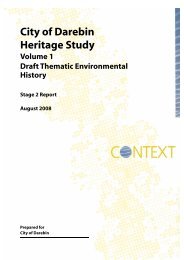INDUSTRIAL LAND USE STRATEGY - City of Darebin
INDUSTRIAL LAND USE STRATEGY - City of Darebin
INDUSTRIAL LAND USE STRATEGY - City of Darebin
You also want an ePaper? Increase the reach of your titles
YUMPU automatically turns print PDFs into web optimized ePapers that Google loves.
4.5 Contributions toDevelopmentCouncil recognised the need to seekcontributions toward the cost <strong>of</strong> theprovision <strong>of</strong> social and physicalinfrastructure incorporating the followingstrategy into the Municipal StrategicStatement in 1999:“Measure the impact <strong>of</strong> newdevelopment and, whereappropriate, require developers tocontribute to additional oraugmented social/physicalinfrastructure.”Council now needs to consider the range<strong>of</strong> mechanisms available to attractcontributions for the renovation <strong>of</strong>streetscapes, provision and upgrading <strong>of</strong>social and cultural infrastructure and thedevelopment <strong>of</strong> an attractive andsustainable environment.Traditional industrial areas have poor orno green space and a very low level <strong>of</strong>amenity with streetscapes dominated bythe provision <strong>of</strong> overhead services,parking, storage <strong>of</strong> materials and wastestorage and no setbacks.Redevelopment <strong>of</strong> identified redundantindustrial buildings and areas is expectedto yield considerable dwellingopportunities and increase residentialdensities. Redevelopment <strong>of</strong> industrialsites/areas for <strong>of</strong>fice purposes can alsohave a similar impact on local servicesintroducing potentially substantialworkforces who require access to localfacilities and a higher level <strong>of</strong> amenity.Some <strong>of</strong> these sites present substantialdevelopment opportunities and this willlead to an increase in demand for existingfacilities and perhaps, where ademographic is substantially impacted,may result in a demand for new facilities.If more sensitive uses are to bepermitted in some <strong>of</strong> the industrialareas, then Council will have toimprove the level <strong>of</strong> amenity inthese areas.Works necessary may includeimprovements such as:• Provision <strong>of</strong> parkland/green spacesor upgrading <strong>of</strong> nearby parks• Planting <strong>of</strong> street trees• Undergrounding (or overheadbundling <strong>of</strong> cable) <strong>of</strong> powersupplies• Rationalization <strong>of</strong> street poles• Roadworks – eg trafficmanagement works• Community and multi-culturalfacilities• Expansion/construction <strong>of</strong> socialinfrastructure such as maternalhealth, aged care, child-carefacilities etc.• Improvements to sewerage anddrainage systems.Improvements such as the upgrading <strong>of</strong>a child care facility would have abenefit to a segment <strong>of</strong> the widercommunity whereas the benefit <strong>of</strong>planting <strong>of</strong> street trees would beconfined to a more immediate locale.Substantial upgrading <strong>of</strong> the existinginfrastructure will be required ifCouncil allows the conversion <strong>of</strong> someindustrial areas for non-industrial uses.Ultimately the responsibility andthus the cost for upgrading thisinfrastructure rests with Council.Council can seek contributions fromdevelopers and the community to fundthese improvements via a number <strong>of</strong>techniques as discussed below.Industrial Land Use Strategy 17
















